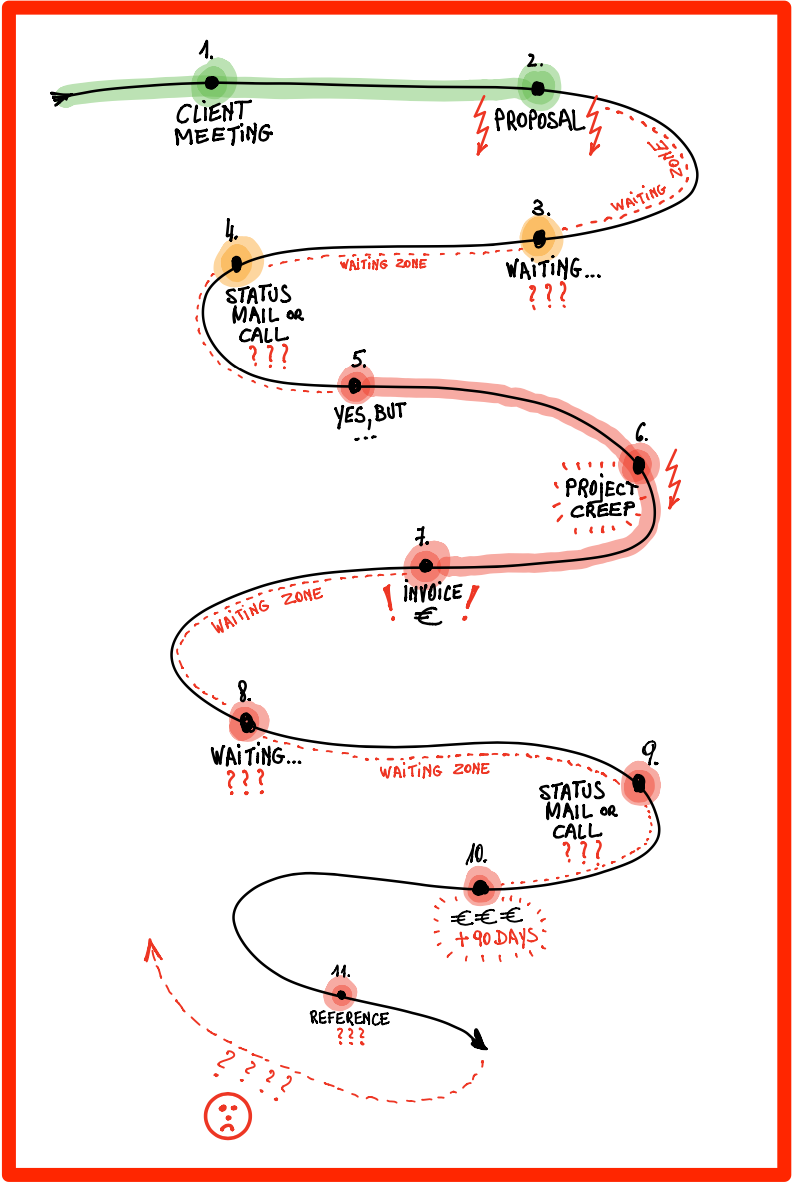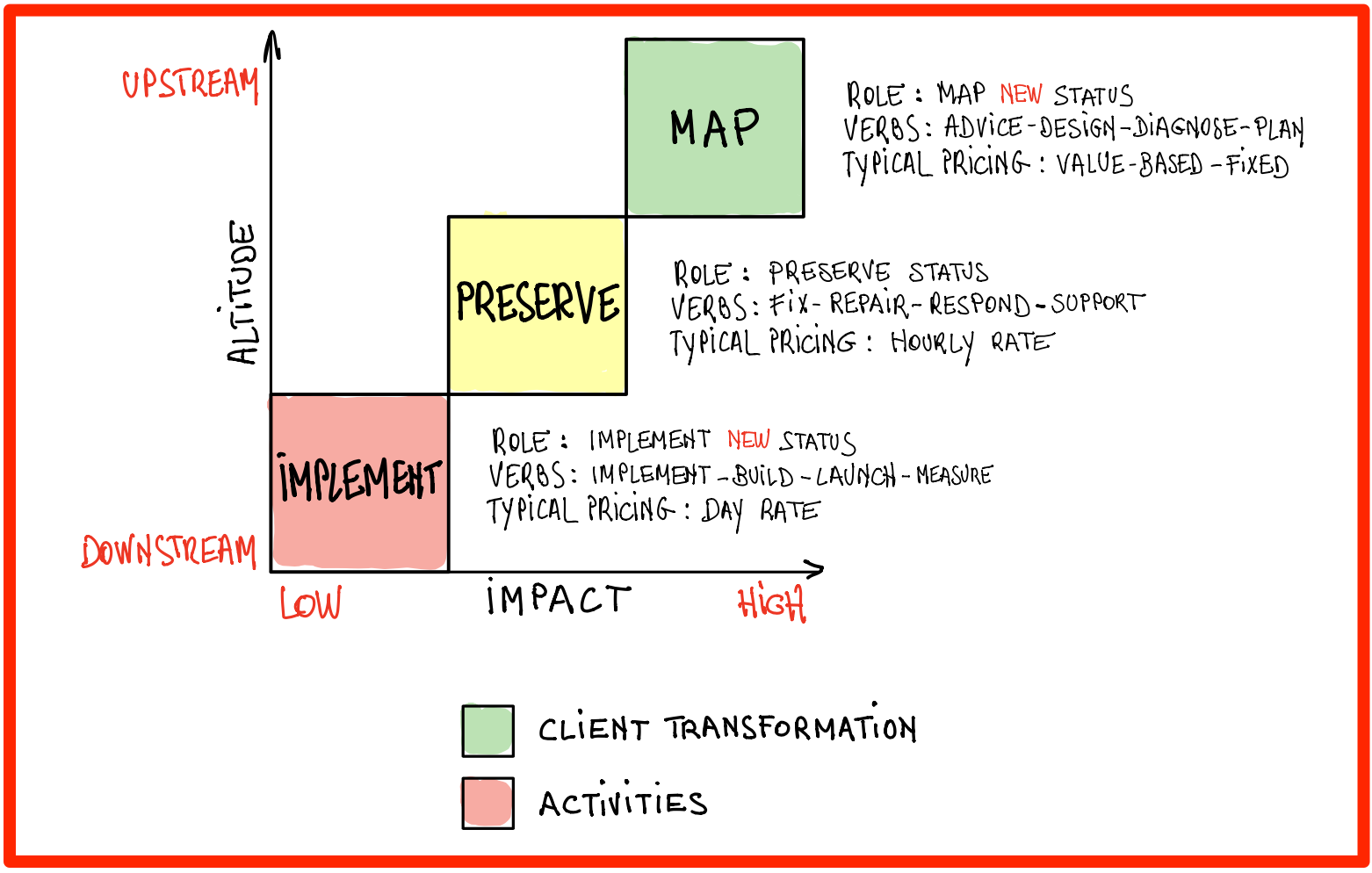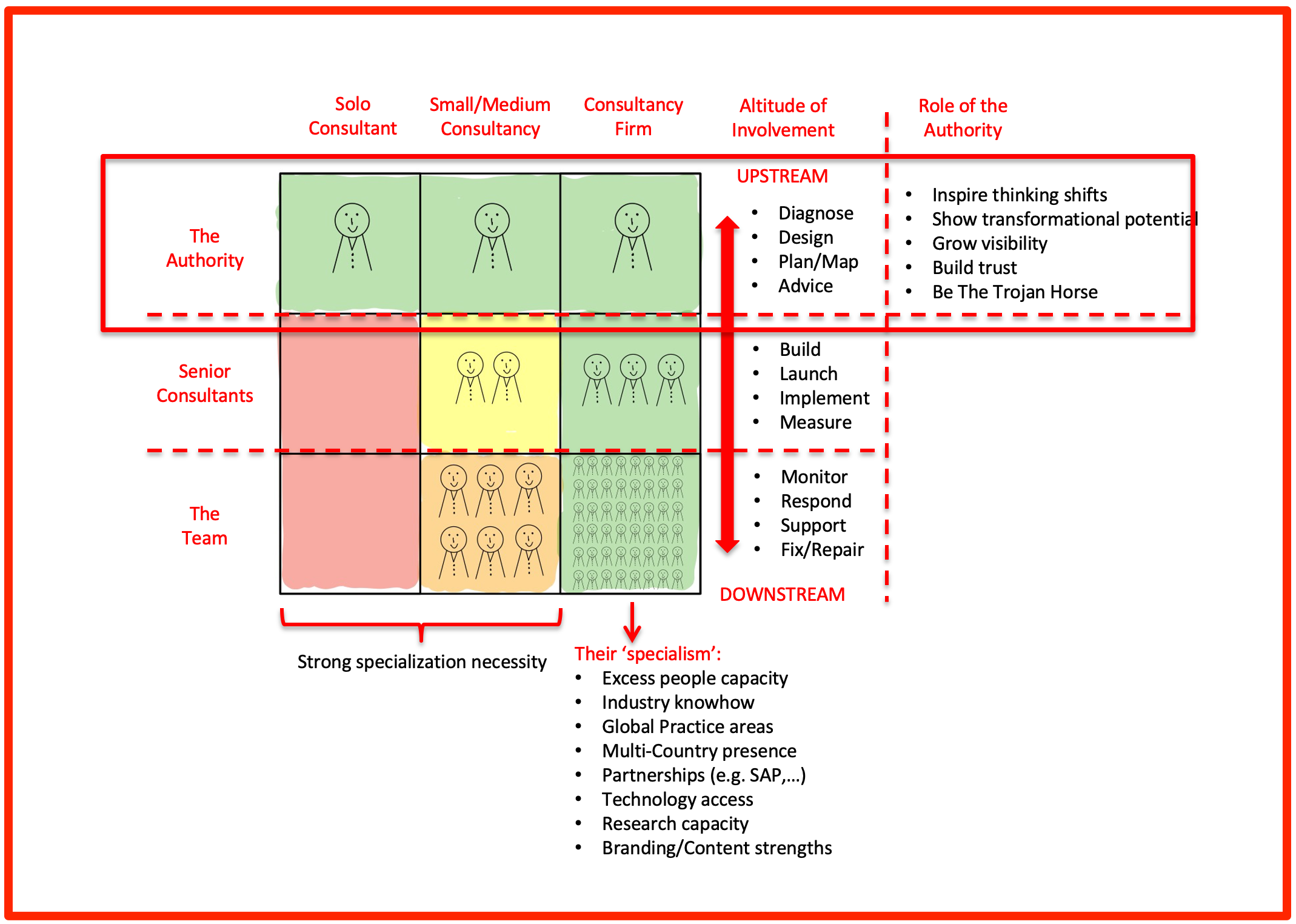
There Are Two Ways Of Doing Consulting, One Is Toxic
.jpg?width=56&name=francescorizzato8%20(1280px).jpg)
I have hosted several virtual workshops for consultants in 2021 already. Each time we got into a lively discussion about - what I call - the toxic ‘Default Consultancy Model’: working crazy hours, responding to a hundred emails from your client’s team every day, (trying to) manage scope creep, chasing payments, spending hours and days preparing proposals, and so on.
Having worked with and talked to hundreds of consultants – and being one myself – I learned that most of the consulting work falls into one of the two categories:
- Low-altitude downstream day-to-day execution/implementation work with relatively low impact, the toxic category
- High-altitude upstream high-level strategic/diagnostic advisory with relatively big impact, the target category
Thank you to the awesome authors for the inspiration to name the categories: David C. Baker (upstream/downstream) and Jonathan Stark (altitude of involvement).
Today, I’d like to talk about transitioning from the former category (downstream - low altitude) into the latter (upstream - high altitude).
It’s a topic that I cover extensively in my workshops and in conversations with clients. But it’s too important to keep in a closed circle. This is something that EVERY consultant needs to internalize.
The Default Consultancy Model – Downstream, Low-Altitude, and (most likely) Toxic
I always ask the participants of my workshops and my clients to describe their most common ‘working model’, starting from the client request. With very few exceptions, they always land with explaining to me the ‘downstream’ type of process, which involves the following prototypical pain points:
- sending a fully customized proposal (and days of unpaid preparation work)
- suffering from demoralizing pricing discussions (and a discount, as a result, thanks to your procurement friends)
- lengthy waiting to get a confirmation (clients can be perversely disrespectful)
- during the project (if you got confirmation after several emails/calls), suffering from a vicious scope creep (the result of YOUR choice to customize)
- getting drawn (again and again) into a wicked invoicing process (with often scandalous payment waiting times)
- finally ending up being afraid to ask for a reference because of the relationship contamination that happens time and time again in this depriving default model…
Here’s a quick illustration of this tedious process:
Figure 1: The Default, Toxic Consulting Model
I can feel your stomach turning upside down, right? I’ve been there in my early consulting years, I know how bad it feels.
And I haven’t even talked about all the other project proceedings and the hundred emails with various team members (the ultimate scope creep). This type of downstream work will eat up most of the time you’d need to develop your consulting business (big or small). It’s the Vicious Loop To Hell…
There are all sorts of things you conventionally do as a consultant that might give you a comfortable feeling. But I got to tell you, in a world where everybody is one click away, you are not safe anymore. (Seth Godin)
I encourage my clients – fellow consultants – to transition from the downstream – low-altitude consultancy model to the transformative, high-altitude model. I’ve done that and you can do it too.

Figure 2: Moving from downstream to upstream, from low impact to high impact (desktop view recommended)
Recommended reading: Consulting USPs need to die a brutal death. Here’s why.
The Transformational Consultancy Model – Upstream, High-Altitude Work
Switching to an upstream ‘client transformation’ consulting approach is THE #1 pillar of success in consulting – the type of success where you are in control of your time, when you comfortably and organically grow your business, when you pick which projects you work on (and say NO to any project outside of your focus zone), where your marketing is inbound, where (in a consultancy firm or boutique) you can be the door opener (the Troyan Horse). Your team can do the revenue-building implementation work.
It’s what happened to me all those years: clients came to me and I didn’t have to sell, negotiate or persuade at all.
As a subject matter expert, you should aim to polish your skills in a narrow field to the extent where you can offer high-level advisory and diagnostic work. You are not concerned with day-to-day execution and management.
Your job, as an authority, is to look at the status quo of your client and present this client with a roadmap that will take the organization from its current pain-ridden state to the ‘promised land’.
This roadmap IS the client transformation that you are selling. That’s the transformational value that you are offering. It’s this type of work that expert consultants get paid at a premium.
It’s this kind of work that allowed me to work far fewer hours and invest time in my business development (approx. 25-30%).
How to Successfully Switch Altitudes with the Authority Grid
I am not going to lie: switching gears is not going to be easy. Especially not within an existing client. I keep advising my consulting clients to upgrade their altitude with new clients, unless you’d feel extremely comfortable ‘selling’ a new, upstream, higher-priced service to an existing client. Not easy though.
If you are considering transforming your offering from execution/implementation, contractor-type of work to strategic/diagnostic advisory type of offering, you have a mountain to climb.
However, getting to a place where clients come to you, your consulting time is remunerated generously, and you finally manage to strike that balance between completing transformational client work and dedicating a sufficient amount of time to growing your consulting business without losing your mind – these are the things worth climbing that mountain for.
Below is an illustration that I refer to as ‘The Authority Grid’.
- The rows: the ‘altitude of positions’: from team workers at lower altitudes of consulting involvement to authorities at high altitude of involvement
- The columns: the consulting ‘business models’, from solo-consultant via small/medium-sized consultancies to large consultancy firms
- The two columns on the right: the role descriptions

Figure 3: The Authority Grid (desktop view recommended)
Probably the easiest way to explain the grid is by explaining my own evolution as a consultant, starting back in 2007 as a solo consultant first, founding iNostix in 2008 and becoming a small consultancy next and ending up in 2016 being a part of large consultancy firm Deloitte, post-acquisition. So, I ‘travelled’ from the left column to the right column.
Without going into too much detail, here are the key messages I’d like to share with you:
- My image on the market never changed. It didn’t really matter in which context I was working (solo-small-big), my role as a ‘Visible Authority’ in all 3 stages never changed:
- inspiring thinking shifts with the prospects,
- showing the transformational potential to future and existing clients,
- growing my visibility in the market (as a result: a healthy organic pipeline all the time),
- building trust by producing an abundance of valuable content and case studies and
- being ‘The Trojan Horse’, the door opener for new projects.
- I always made sure to free up the time. Despite ‘traveling’ from left to right in the grid, I never ever left this Authority role, and I always managed to free up 25-30% of my time to grow my visibility and to deepen my expertise (learning, reading, studying like hell).
- I always stayed upstream. Freeing up my time was only possible by staying upstream, especially in the initial solo- and small-consultancy periods. That’s why I painted it red in the solo column. Going downstream would have stopped me from investing enough time to grow.
- I avoided going downstream at all costs. Be ‘an upstreamer’! If you are a solo consultant (and even the small consultancy teams), my advice is to stay away as much as possible from downstream work as
- you will never be able to compete with the ‘excess capacity’ of the larger consultancies and
- you will have to work to death to earn a decent living (as your rates will be low in the downstream zone).
- I assessed every incoming opportunity. By moving up to a small consultancy with a team behind me, it became easier to use my upstream position to accept selected downstream work. I painted the middle- and downstream areas yellow and orange in the grid because it’s extremely important to ASSESS every opportunity against a narrow focus zone. If you leave your lane to protect your short-term income (I can understand), you will cease to develop your expertise and you won’t be able to leverage expertise-related recommendations or social proof. Don’t leave your lane! Never!
- I got in the habit of charging for upfront work. In this middle column (small/medium size), it became possible for me, with my rapidly growing reputation in my markets, to start charging premium rates for (upstream) UPFRONT DISCOVERY, problem diagnosis, and roadmapping. Compared to what most other consultants do: charging for (downstream) implementation work and doing the upfront discovery and problem diagnosis for free (spending way too much unpaid time developing customized proposals).
- I continued to specialize. I keep telling my clients: as a solo practitioner or small consulting team, the necessity to specialize and focus becomes much more important to be able to stand out in a crowded market. Your success will lay in the upstream work as you won’t be able to compete with larger consultancy firms with their excess (downstream) capacity.
- I was always acutely aware of the importance of focus. Last but least, as part of a large consulting firm, I was able to create incredible opportunities, much broader, bigger, more impactful. But...my role didn’t change! The business model of the large consulting firm is to sell ‘excess capacity’ and that often poses the risk of losing focus or getting too much into a managerial role. But it also gives tremendous opportunities to sell large projects. Anyway, watch out for becoming a ‘laundry list driven’ manager instead of a visible expert with a strong reputation in the market. Don’t get sucked into ‘working in the shop’ but keep working on ‘building the shop’.
- I placed the appropriate price value on my time and expertise. I get that question all the time: show us the numbers behind my ‘travel’ from right to left. Here you go (I've never given this info before): as a solo consultant, projects varied from 30-50k; as a small consultancy, projects varied from 100-150k; as part of a large consultancy firm, projects varied from 250-500k.
Start thinking differently
We must simply choose to take control, first by specializing and shifting the power back from the client toward us, and then we can begin to shape our future as consultants. (Blair Enns in his book: 'Win without pitching')
If you keep your options open as a generalist consultant or consultancy (because you are afraid of losing business) and you don’t focus your consulting work on solving a specific (expensive) problem from a specific (minimal viable) audience in a specific (packaged) way, you will most likely get stuck in the ‘default consulting model’ forever.
Think about that. Switching models may be difficult, but, in relative terms, it’s short-term pain. Getting stuck in the default model will haunt you for the rest of your consulting career.
Strive to Answer These Questions as an Upstream Advisor
As you devise your transition plan, think of these questions as mileposts – a way to know if you’re on the right track and how far you are from reaching your destination:
- Do I have a laser-sharp focus area?
- Does this translate into the narrowest possible definition of my target audience?
- Do I fully grasp the prototypical pains of this audience? (expensive pains!)
- Can I clearly describe in 30” what transformational value I can bring to solve these prototypical pains?
- Can I picture ‘the promised land’, the transformation, the final output, the result, the impact of my intervention?
- Can I describe how they can get to the promised land?
- What process do I advise clients to use? What’s my ‘vehicle’ that brings them from pain to gain?
- How do I organize a transformation ‘home run’?
- How will I ensure full client buy-in and commitment?
In Summary: It’s Time to Get Rid Of Your Downstream Positioning as a Consultant
So, to keep a long story short: I got rid of my downstream, non-authoritative positioning as a consultant (low altitude of involvement) and you should stop this way of working (and thinking) too:
- Stop ‘doing activities’ for your clients (instead you should be focusing on 'doing high impact client transformations')
- Stop being considered as ‘one-to-many, without any negotiation power (experts are hard to get and they say no to non-ideal clients to protect their focus and time to grow the consulting business)
- Stop working at a low hourly/day rate (working yourself to death to earn a living)
- Stop adding the terms 'interim', 'contractor', 'freelance' or 'opentowork' (on Linkedin) to your profile (with all due respect for interim, contractors or freelancers!) (adding these terms to your consulting profile will dilute your authority/upstream positioning and put you in the downstream pricing club)
- Stop doing unpaid work for clients, so called 'to get access', it's the ultimate erosion of your expert profile (you could do free work in the context of a special pilot, for validation purposes...but that's a totally different thing)
- Stop being considered risk-free to get replaced (unexpectedly) by your buyer/client
- Stop getting stuck in the vicious ‘default consulting model’ (see figure 1 above), you charge for upfront work and leave the implementation work to others inside or outside your team
I moved to an upstream, transformational value proposition as an expert step-by-step and never had to deal with the vicious ‘consultancy default model’ again. What about you in the coming months?
Recommended reading: Consulting USPs need to die a brutal death. Here’s why.
Interested in receiving all my learnings to become a better consultant? No spam, no BS. Pure teaching! Subscribe to my newsletter.
.jpg?width=66&name=francescorizzato8%20(1280px).jpg)
Luk’s extensive career in the consulting business, which spans more than 20 years, has seen him undertake a variety of influential positions. He served as the European CHRO for Nielsen Consulting (5,000 consultants in the EU), founded iNostix in 2008—a mid-sized analytics consultancy—and led the charge in tripling revenue post-acquisition of iNostix by Deloitte (in 2016) as a leader within the Deloitte analytics practice. His expertise in consultancy performance improvement is underlined by his former role on Nielsen's acquisition evaluation committee. After fulfilling a three-year earn-out period at Deloitte, Luk harnessed his vast experience in consultancy performance improvement and founded TVA in 2019. His advisory firm is dedicated to guiding consulting firms on their path to becoming high-performing firms, drawing from his deep well of consulting industry expertise and financial acumen.

